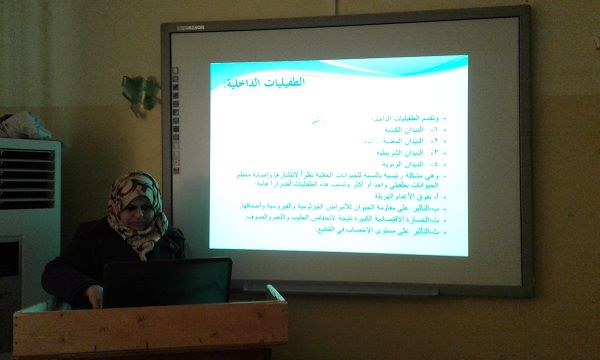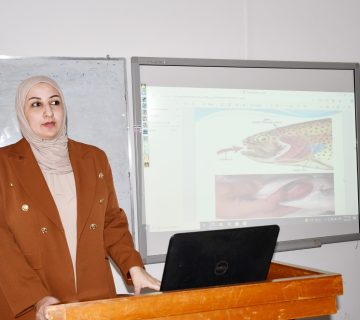Internal Medicine Branch was held at the Faculty of Veterinary Medicine / University of Qadisiya seminar entitled (lung worms in farm animals and ways to address them).
Objective: to identify the types of pulmonary worms that infect some farm animals and clinical signs and pathological changes caused by these worms in farm animals and methods of diagnosis, treatment and control of that.
Summary:
Worms infect the lung airways in some farm animals like cows, sheep, goats and horses, causing respiratory diseases, and these worms Dictyocaulus viviparus in cattle, Dictyocaulus filaria and Mullerius capillaris and Protostrongylus rufescence in sheep and goats, and Dictyocaulus arnfieldi in horses.
Dense infestation lead to the emergence of pulmonary clinical signs: cough, difficulty breathing, increased nasal secretions, and decreased appetite and weight decrease, the high temperature in the event of a minor injury.
Pathological changes: the lesion in the lung cows are hardening in the lobe of the lung phrenic diaphragmatic lobes. See worms in the bronchi. In addition to the presence of perfusion eosinophilic exudate fills the bronchioles. While in infected sheep and goats hardening it appears in lung injury D. filaria and P. rufescens while injury M.capillaris Al lesion appears as small fibrous contract. But the horses are no adult parasites in the small towns and revealed infiltration of inflammatory cells and increased secretion of mucus and sometimes clogged bronchitis.
The laboratory diagnosis by examining a stool sample and watch the eggs and larvae of worms pulmonary addition to the use of screening enzyme -linked immunosorbent assay (ELISA) using either the control counter medicines for worms and a wide spectrum such as Benzimidazoles, avermectins / milbemycins treatment and imidazothiazoles
Results:
1. cause infestation in the field of pulmonary animals verminouspneumonia verminous bronchitis bronchitis and pulmonary inflammation.
2. You need M.capillaris and P. rufescens to the medial host of mollusks
3. severe injury occurring in small-old animals
4-phase infectious larva is in the third phase
5. abound injury in the cold and wet seasons.
Recommendations:
1-periodic use of preventive treatments as a preventive measure for the animals ready for the disease and the treatment of animals bearing carrier of the disease to prevent contamination of the pasture.
2. advisable to conduct laboratory tests of animals
3. The application of methods of care through grazing animals away from infected animals or avoid contaminated pastures.
4. Separate large grazing animals for small animals.
Present this episode m. Zafar Rashid Hamid Afattla in Hall No. 4 in the branch.






لا تعليق